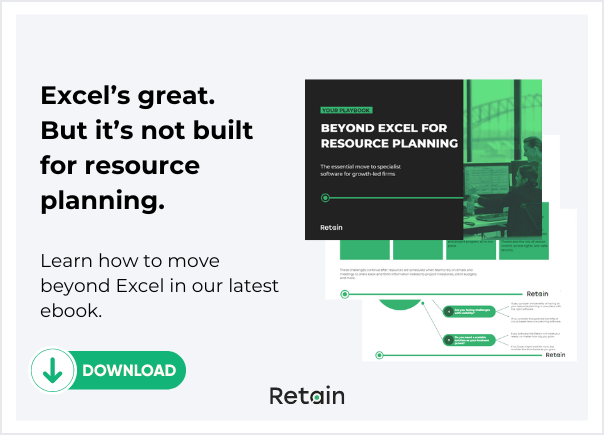In a business environment marked by economic unpredictability and rapidly changing priorities, proactive and efficient resource planning is key to adaptability and precision. This is where your 2024 resource management plan comes in.
It’s a vital strategic asset, mapping out the optimal use of a business's resources—including human skills, technological systems, financial assets, and physical equipment.
The aim? To balance the demands and availability of resources, whilst allowing flexibility to adapt to unforeseen changes. With this in mind, we’re dedicating this blog to delving into nine essential steps for crafting a comprehensive resource management plan for 2024—and beyond.
#1. Going beyond Excel
While Excel spreadsheets have served us for decades, relying solely on manual processes just isn’t going to cut it anymore. Putting it bluntly, Excel is a huge time sink, formulas are complicated and easy to break. And if an emergency happens, it’s just not got the capabilities to support resource planning because it simply isn’t made for that.
For example: If you wanted to quickly assign the best person with specific experience in certain sectors, nuanced skills in things like Javascript, or even time spent working with a client to know them – this is too complex and clunky for Excel to crunch.
On top of this, it puts you on the back foot before you’ve even begun when others are leveraging tech to rapidly manage workload fluctuations with visibility across the entire operations.
Put simply, digital tools have advanced far beyond basic data storage and calculations. Offering advanced analytics, automation and interoperability, these technologies streamline resource management with smart and quick decision-making. Rather than a trend, this is now a baseline requirement for streamlined operations.
Keen to learn more? Check out this blog: Outgrown Excel? Here’s how to move to a specialist resource management system.Or download our new ebook:

#2. Agile methodologies
Rapidly responding to customer needs, jugging high-priority clients, and keeping on top of market trends requires agile resource planning.
Why? Because agile methodologies enable effortless pivoting of resources to emerging demands or opportunities. This flexibility will be of huge value in your 2024 resource management plan. It might just be the only way to survive in an unpredictable climate.
Whilst this may be obvious, the solution to this challenge isn’t as well-known which means you’ve got old vs new ideas competing out there:
✏️Old: Businesses lean on traditional, manual methods that severely limit speed and visibility, obstructing informed decisions.
⚙️New: Whereas with automation tools, you can expect a simple and transparent way to view capability, availability, project outlooks and more. Supported by these technologies, agile methodologies offer responsiveness at scale, aligned to business conditions.
It’s easy to see how this is creating an unbalanced competition.
Ready to learn more? ? Read: Resource planning in project management: Boost efficiency and profit
#3. Leverage AI in resource management
Yes, that’s right. Artificial Intelligence may have taken on other industries but it’s also hit resource management too and market leaders are actively using it.
Here are just a few ways AI makes a difference:
🟢 Predictive capability: The era of making educated guesses or relying solely on historical data is fading. AI analyses patterns, grasps emerging trends, and forecasts potential future challenges and needs.
🟢 Task automation: Those time-consuming, repetitive tasks that added little strategic value? AI takes over these tasks, ensuring consistency and accuracy, while freeing up valuable time for more critical, strategic decision-making.
🟢 Continuous learning: AI doesn't just perform tasks; it learns from them. It continuously adapts and fine-tunes its recommendations based on every project and every change it encounters. This results in a system that not only keeps pace with your business but also constantly strives for the most effective outcomes.
Essentially, by processing billions of data points in seconds, it can optimise resource allocation both now and in the future.
Sounds intriguing? ?Learn more about this here: Understanding AI in resource management
#4. Advanced skills matching
Knowing exactly how to effectively deploy your team's diverse skills is what resource planning is all about. But carefully matching advanced skills isn’t something every resource planning system can manage. For example, rather than categorising team members simply as a ‘data analyst’, modern systems like Retain, can look for specific competencies such as Javascript expertise.
But that’s not all. Beyond technical skills, it’s also vital to consider team members' experiences with specific clients and industry sectors. This is where a comprehensive approach to resource allocation comes in. It taps into both hard skills and contextual understanding and takes into consideration past experience too.
The result? This nuanced approach to skills matching ensures you’re selecting the right person for each project, to elevate the quality of the work output, hit deadlines, and optimise resource utilisation – without overworking employees.
Learn more: ?What is resource allocation? Expert insight for a balanced workplace
#5. More efficient collaboration
Leading businesses are establishing a 'single version of the truth' for 2024 resource management planning.
What does this mean? It means one unified, accessible source of information on resource planning, schedules, project requirements and more. It makes for better teamwork and communication. More streamlined processes. And, on top of this, it minimises confusion, allows for seamless integration between systems like HR tools, and improves data accuracy for reporting and forecasting.
To sum it up: At its core, integration enables business-wide transparency and responsiveness. Teams can sync up faster, resources are optimally directed and project delivery is accelerated. Collaborative momentum compounds, strengthening strategic agility.
Looking for more tips? Check out this guide: Resource planning: The new essentials
#6. Customisation
Striving for a one-size-fits-all solution in resource management often leads to strategies that go astray. So, for 2024 resource management plans, businesses today are embracing platforms tailored to their specific operations, priorities and growth plans. That’s where customisation comes in.
Purpose-built systems open up an abundance of benefits. Here are just a couple:
Focuses on what matters most: whether it's unique reporting formats, specific workflow automation, or particular integration requirements with existing systems.
Meets objectives: It enhances decision making, sharpens project delivery and amplifies impact across organisations.
Whether you’re new to tech or potentially in need of a better platform for resource management, this next blog has you covered.
Read: How to build a business case for resource planning software (+ free template)
#7. Evidence-based decision-making
As resource management advances with the likes of AI, it’s easy to see how data is taking away the guesswork from resource management. Leveraging quantitative inputs like historical performance, external trends and forecasts, businesses can shift from intuition to evidence-based planning in 2024.
For example: Smart analytics systems make it easier to spot patterns in utilisation rates, accuracy metrics, cycle times, and more. Armed with this intelligence, you can optimise resource levels, realign capabilities and foresee future needs.
The bottom line is, that a data-driven approach takes you from reactive to proactive planning – enabling decisions that go beyond immediate requirements. And building analytics into planning processes creates an agile foundation built on evidence.
#8. Risk mitigation
But, of course, smooth operations rely on more than flawless execution. The ability to rapidly respond to surprises is integral to progress – hence risk management has become central to resource strategy, equipping teams to navigate disruption.
So, how are leading businesses tackling this in their 2024 resource management plan? They’re methodically assessing likelihoods and impacts across different scenarios from staff attrition to system failures. Identifying vulnerabilities early enables proactive planning through contingencies and cross-training.
Robust planning also requires continuously reevaluating assumptions as conditions evolve. Regular risk assessments foreground potential blind spots, prompting mitigation before operational crises emerge.
The bottom line? By focusing resources on risk anticipation rather than reaction, businesses can uphold continuity despite turbulence. For in-depth methodologies on building risk-ready management frameworks, see our dedicated resilience blog.
Want to learn more? Read: How resource forecasting helps with risk management
#9. Client centricity
Aiming for exceptional service and achieving high client satisfaction? Then your 2024 resource management plan should revolve around a client-centric strategy. This means understanding and meeting the specific requirements of each client.
By doing so, businesses can ensure that their resources – be it human expertise, technological tools, or time – are allocated in the most effective way to address client needs. This alignment to resource management leads to better outcomes for both the business and its clients. When resources are managed with the client's needs at the forefront, projects are more likely to be completed efficiently, within budget, and to the client's satisfaction.
The result? This approach creates a sense of partnership and collaboration, making clients feel valued and understood. Plus, this alignment results in enhanced client satisfaction, repeat business, and a strong reputation for being a client-focused organisation. It’s a winning formula for both the client and your business.
Boost your 2024 resource management plan
From adopting advanced digital tools to embedding analytics and automation, to leveraging AI for predictive optimisation, these technologies reshape strategy. Additionally, methodologies like skills mapping, data integration, customisation, and risk mitigation inject insight and versatility.
Key takeaway: Combined, these interlinked elements create an agile planning foundation equipped for the year ahead. As conditions continue evolving, a dynamic resource management strategy will prove critical to navigation and growth.


